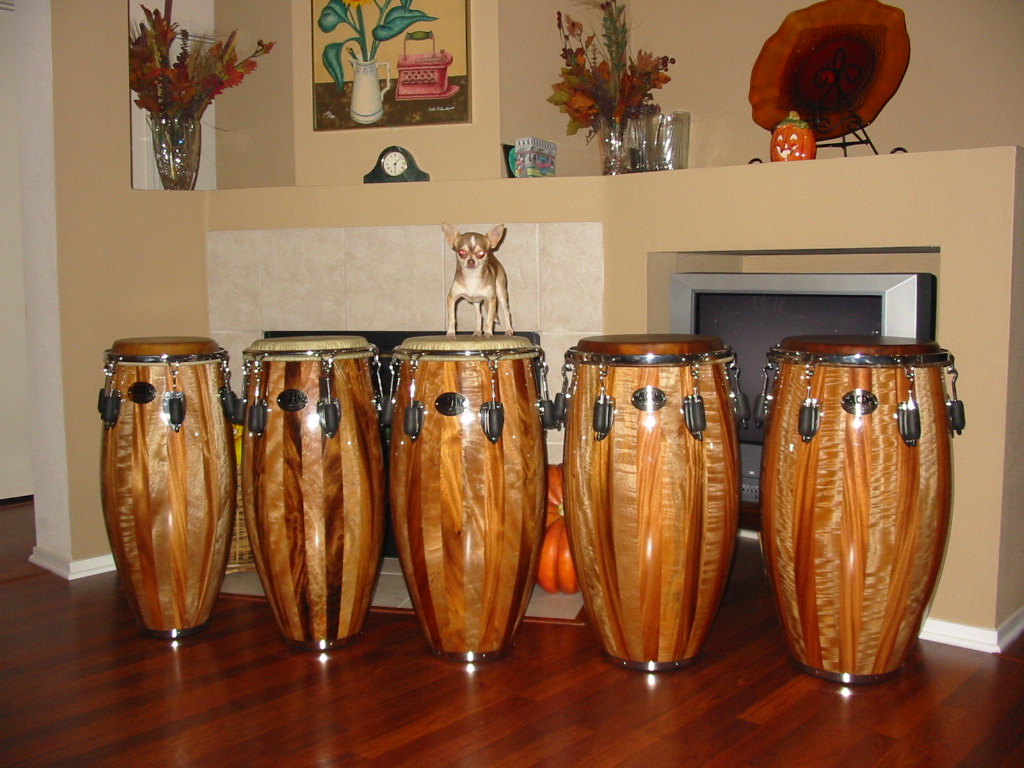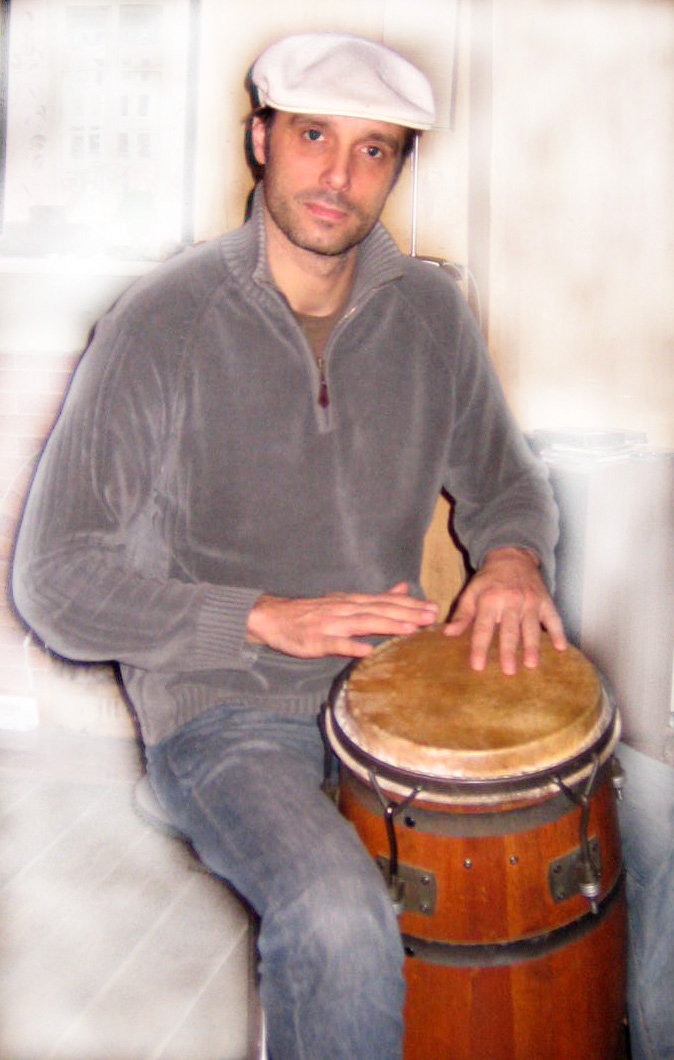Tuning
14 posts
• Page 1 of 1
There seem to be so many answers to tuning. It comes across as a one of the harder areas of conga use.
4ths, 5ths 6ths apart etc. For the newcomer this can be a real show stopper. Is there a particular note or notes on a keyboard that could be used as a guide for tuning. To have a starting point would be good...
4ths, 5ths 6ths apart etc. For the newcomer this can be a real show stopper. Is there a particular note or notes on a keyboard that could be used as a guide for tuning. To have a starting point would be good...
-

gav - Posts: 12
- Joined: Mon Apr 02, 2001 11:30 pm
- Location: London, UK
Kracker wrote:A couple of books I've read suggest 'Middle C' for the conga and 'G' below for the tumba. First two notes in Here comes the bride!
Hope this helps - Kracker
It's not really as simple as that. Many drums have a sweet spot in the tuning where they are most resonant and it makes sense to tune to that, if possible. It could be C for a particular drum, but then again it could be B or C-sharp or D or whatever. As for which drum in a 2 or 3-drum setup should get the optimized tuning and which should be tuned a 4th or 5th or whatever above or below that, that's also not so simple.
Considerations:
- The open tone of the segundo is typically the most heard and most important tone, and personally I think it makes the most sense to tune that first, if possible. Others have said the tumba, and I'd like to hear the reasoning behind that suggestion.
- Sometimes you have one drum that has a much narrower range of good tones, where it gets ringy even only a little above or below, or sounds dead or whatever, and if that's the case you might optimize the tuning for that one first and use it as the base.
- If you're playing a type of music where your open tones are an integral part of the melody, it might be important to tune to a particular scale, song, other instrument, etc.
- Keep in mind that the "Hear comes the bride" trick is really more about the INTERVAL (a perfect fourth) than the actual notes.
http://www.musicalintervalstutor.info/listenpg.html
Good page of other songs with various intervals:
http://www.people.vcu.edu/~bhamme....ze.html
If the whole fourths and fifths of music theory are not something you want to deal with but you want to be more precise than humming "Here comes the bride," just to pick a note on a piano and go up or down 5 keys - the black or white key, whichever is next - and you'll get to the next note in the perfect fourth interval. C to F, F to A-sharp, etc. If you want to try a fifth, just go up 7 keys instead of 5, so you'd have C to G, or G to D, etc. Here's a little keyboard you can use:
http://www.ababasoft.com/music/piano.html
~Taiko
Edited By taikonoatama on 1178238262
-

taikonoatama - Posts: 322
- Joined: Tue Mar 29, 2005 10:11 pm
- Location: San Francisco Bay Area
Agree that there is personal choice re: the interval - but personally I too go for the "Here comes the Bride" 4th. Also sounds right to my ears for the Guaguanco melody. When that sounds off to me I know I need a little adjustment.
When I found the sweet spot on my drum I've also then used a Guitar tuner to try and figure out what note that was on the drum - with all the overtones its pretty inexact and the tuner will waiver and jump around! but hit an open tone 20 times and you can say "well its pretty close to D (or whatever)" and work from there.
When I found the sweet spot on my drum I've also then used a Guitar tuner to try and figure out what note that was on the drum - with all the overtones its pretty inexact and the tuner will waiver and jump around! but hit an open tone 20 times and you can say "well its pretty close to D (or whatever)" and work from there.
Burke
- burke
- Posts: 753
- Joined: Thu Sep 23, 2004 2:50 pm
- Location: Nova Scotia
-

windhorse - Posts: 1442
- Joined: Mon Dec 29, 2003 9:01 pm
- Location: Boulder/CO
Hy there gentalmen i have to say that was a nice explanation by taiko . Very nice i'm going to save it , thanks. I like the interval noted by ( here comes the bride ) although my instructor says always melodic thats the ticket . Deep tumba nice contrast on the open on the conga with a sharp slap .
thanks rumbaman
thanks rumbaman
- rumbaman
- Posts: 199
- Joined: Fri Oct 03, 2003 2:35 pm
Wow, these comments are very informative thanks everybody.  I've been tuning it to my ear and I was very close to hear comes the bride. Sometimes I tweek it a little higher for the beautiful latin tunes and go back to the her comes the bride on the rock tunes.
I've been tuning it to my ear and I was very close to hear comes the bride. Sometimes I tweek it a little higher for the beautiful latin tunes and go back to the her comes the bride on the rock tunes.
Julian Melendres
-

JulianM - Posts: 10
- Joined: Mon Oct 22, 2007 2:29 pm
- Location: Antioch, CA
taikonoatama wrote:Kracker wrote:A couple of books I've read suggest 'Middle C' for the conga and 'G' below for the tumba. First two notes in Here comes the bride!
Hope this helps - Kracker
- The open tone of the segundo is typically the most heard and most important tone, and personally I think it makes the most sense to tune that first, if possible. Others have said the tumba, and I'd like to hear the reasoning behind that suggestion.
I'm going to attempt a reason for tuning the tumba first, though I really like your explanation of why tuning the Segundo first.
The larger the skin, the more possibility to stretch, or tighten given changing weather conditions, like what we're experiencing here now in Colorado.
So, often the drum you find most out of tune - assuming you're consistently tuning your drums - is the lowest one. And the low one - at least for me - is the one that seems so wierdly out-of-tune and makes me smile when it's right on. Then, I can go up the ladder doing the intervals in a consistant approach, rather than the up above and down below approach that you have to do from the middle drum.
OK, there's a reason, though it's pretty shaky.. :p
-

windhorse - Posts: 1442
- Joined: Mon Dec 29, 2003 9:01 pm
- Location: Boulder/CO
I don't have a piano, but I do have a guitar and guitar tuner. Could those be used for tuning purposes?
Should I turn the nuts quarter or half turns at a time? Should I tune down for my first attempt? (to avoid overtightening) Is there a good way to tell if the tension is even on all lugs? I have a million questions to every answer
Should I turn the nuts quarter or half turns at a time? Should I tune down for my first attempt? (to avoid overtightening) Is there a good way to tell if the tension is even on all lugs? I have a million questions to every answer
- hoofbeats
- Posts: 22
- Joined: Wed Oct 17, 2007 6:23 am
- Location: Michigan
taikonoatama wrote:the perfect fourth interval. C to F, F to A-sharp
Oh, boy-- time to be petty, anal, and totally insensitive to an otherwise great post... :;):
F to A# is an augmented third, technically. To be accurate, the perfect fourth would be F to Bb. They are enharmonic, but the theoretical use would be different in a composition.
But enough of that-- Taiko, thanks for a great post. I think I learned something there.
- Whopbamboom
- Posts: 588
- Joined: Sun May 13, 2007 8:02 pm
the best way to know if all lugs are tuned the same, for me, is to hit the skin close to the edge above the lug with the side of the wrench (having the wrench facing upwards, hitting with the rounded edge of the wrench).
Give it a nice bouncy hit and you should hear a clear note.
Then compare it to the next one and tune the whole drum until hey all sound exactly the same, and only then go back to tuning the drum as a whole using quarter turns only.
Having all the lugs tuned the same can be very important to get a full sound from your drum and will make it easier to achieve global tuning.
Another way, but a bit of harder, is to listen to the harmonic of the drum.Place your middle finger vertically facing down in the exact middle of the drum. Use a light touch.
Then hit the drum with one finger on the side of the drum with a very bouncy hit above the lug ( not as easy as it sounds), again you should hear a clear note.
good luck, and for those of you who have never done this, enjoy your new drums!
peace
Give it a nice bouncy hit and you should hear a clear note.
Then compare it to the next one and tune the whole drum until hey all sound exactly the same, and only then go back to tuning the drum as a whole using quarter turns only.
Having all the lugs tuned the same can be very important to get a full sound from your drum and will make it easier to achieve global tuning.
Another way, but a bit of harder, is to listen to the harmonic of the drum.Place your middle finger vertically facing down in the exact middle of the drum. Use a light touch.
Then hit the drum with one finger on the side of the drum with a very bouncy hit above the lug ( not as easy as it sounds), again you should hear a clear note.
good luck, and for those of you who have never done this, enjoy your new drums!
peace
tone
-

Tone - Posts: 191
- Joined: Sun Jan 04, 2004 12:03 am
- Location: Rio de Janeiro, Brazil
14 posts
• Page 1 of 1
Return to Congas Technique, Rhythms and Exercises
Who is online
Users browsing this forum: No registered users and 5 guests